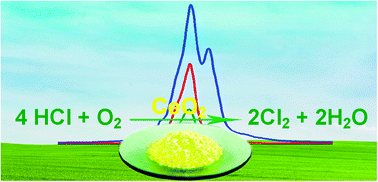CeO2 has been identified as an efficient catalyst for HCl oxidation in the temperature range of 623-723 K provided that the oxygen content in the feed mixture was sufficiently high to avoid bulk chlorination and thus deactivation. Here we characterise ceria in its fresh and post-reaction states by adsorption of CO2, NH3 and CO. Micro-calorimetry, FTIR and TPD experiments are complemented by DFT calculations, which assess adsorption energies and vibrational frequencies. The calculations were performed on the lowest energy surface, CeO2(111), with perfect termination and with various degrees of hydroxylation and/or chlorination. Both experiments and calculations suggest that the basic character of the ceria surface has been eliminated upon reaction in HCl oxidation, indicating that most of the basic lattice O sites are exchanged by chlorine and that the OH groups formed are rather acidic. The density and the strength of surface acidic functions increased significantly upon reaction. An in situ FTIR reaction cell has been designed and constructed to study the evolution of OH group density of the ceria surface during HCl oxidation. The effect of experimental variables, such as pO2, pHCl and temperature, has been investigated. We found that the OH group density positively correlated with the reactivity in the pO2 and temperature series, whereas negative correlation was observed when pHCl was varied. Implications of the above observations to the reaction mechanism are discussed.
